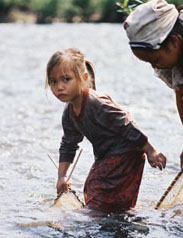8.7 WHY CONSERVE BIODIVERSITY?
Direct
use value / Indirect
use value / Option
value / Economic
valuation
Functional and Intrinsic Value--
We do not know how many species live on planet Earth; therefore it is
not surprising that we do not know what the ecological role of each of
them. Perhaps there is a relationship between stability and complexity,
whereby ecosystems with more species are more stable. In most cases, we
cannot predict with certainly the effects of the loss of one or more species
from an ecosystem. The changes may be minor if the functional role of the absent species can be compensated for by
another species (i.e., if there is overlap or spare capacity in the system).
However, removal of a species upon which others depend (perhaps because
it is an important food item), may lead to a chain reaction and the loss
of many other species. Ideally, this uncertainty would mean we should
adopt the precautionary principle: i.e., act carefully to ensure that
we preserve all species.
if the functional role of the absent species can be compensated for by
another species (i.e., if there is overlap or spare capacity in the system).
However, removal of a species upon which others depend (perhaps because
it is an important food item), may lead to a chain reaction and the loss
of many other species. Ideally, this uncertainty would mean we should
adopt the precautionary principle: i.e., act carefully to ensure that
we preserve all species.
Many people believe that biodiversity and natural landscapes are 'good
things' with intrinsic or inherent value. This variety has non-use values
for humans through enrichment of culture, religion or aesthetics, and
should be preserved. However, this view is by not held by all. What is
the value of biodiversity?
Direct Use Value--
Biodiversity can provide resources of direct value to humans when it is
consumed or turned into a marketable product. Biodiversity can be used
directly as food (e.g., Mekong fisheries: see Section 12), a source of
medicines, as agents of biological control of pests, and as a source of
industrial materials (e.g., wood, rubber, dyes) and genetic raw material
for new agricultural varieties. Recreational harvesting (for the pet and
aquarium trade) and ecotourism come under this category also.
Indirect Use Value--
Biodiversity provides services that are essential to the well being of
the ecosystems that they make up and upon which humans depend. These can
be regarded as 'free' in that they are not traded in markets. This category
includes the many organisms that form the base of food chains that support
fisheries, and the insects that pollinate agricultural crops and other
plants. Forests have an indirect use value in the maintenance and generation
of soil cover, and their influence on hydrology through river flows and
flooding. The use of organisms for genetic research that can eventually
be applied to benefit humans is another indirect use of biodiversity.
Option Value--
Once extinct, species are lost forever. Humans may place value on the
option of retaining biodiversity for direct or indirect use in the future.
This may be viewed as the intergenerational value of biodiversity through
the heritage it represents for future generations.
Economic Valuation--
At present, policy-makers tend to treat water as a free resource, and
do not take account of its indirect use value as a 'public good' on which
rivers, floodplains and their biodiversity depend. Realistic economic
valuations of rivers and other inland waters will be an essential first
step toward a change in attitudes. Constanza et al. (1997) estimated  the
values of direct use of biodiversity (e.g., food in the form of fishes),
indirect use (as ecosystem services), and cultural considerations. A global
value of US$6,579 x 109/year was estimated for all inland waters. It exceeded
the worth of all other non-marine ecosystems combined (US$5,740 x 109/year),
despite the far smaller extent of inland waters. This is because the average
per unit area value of rivers (US$8,498/ha) and wetlands (US$14,785/ha)
far exceeds the most valuable terrestrial ecosystems (forest US$969/ha;
grasslands US$232/ha). Although there are uncertainties in these estimates,
the value of inland waters is certain to increase in future as ecosystem
goods and services (especially unpolluted fresh water) become more stressed
and scarce.
the
values of direct use of biodiversity (e.g., food in the form of fishes),
indirect use (as ecosystem services), and cultural considerations. A global
value of US$6,579 x 109/year was estimated for all inland waters. It exceeded
the worth of all other non-marine ecosystems combined (US$5,740 x 109/year),
despite the far smaller extent of inland waters. This is because the average
per unit area value of rivers (US$8,498/ha) and wetlands (US$14,785/ha)
far exceeds the most valuable terrestrial ecosystems (forest US$969/ha;
grasslands US$232/ha). Although there are uncertainties in these estimates,
the value of inland waters is certain to increase in future as ecosystem
goods and services (especially unpolluted fresh water) become more stressed
and scarce.